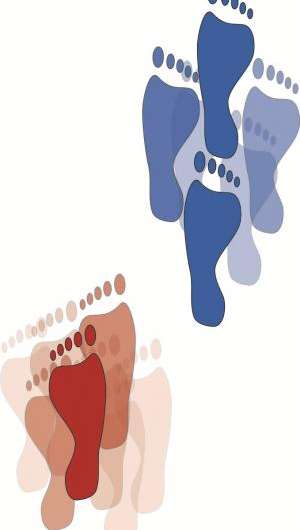By watching people walk, researchers decode the foot position's role in maintaining balance

Researchers at The Ohio State University have gained new insight into how the body moves when we're walking. They learned everything they needed to know by watching people walk naturally on a treadmill.
In normal walking, humans place their foot at slightly different positions on each step. To the untrained eye, this step-to-step variation in foot position just looks random and noisy. But in the Sept. 24, 2014, issue of the journal Biology Letters, the researchers describe a mathematical model that can explain over 80 percent of this apparent randomness in the location of a person's next step, based only on tiny variations in the movement of that person's pelvis.
Every step we take is a balancing act as the body falls forward and sideways, explained Manoj Srinivasan, assistant professor of mechanical engineering and the head of the Movement Lab at Ohio State.
"We were able to show that the next foot position can be predicted way in advance of when the foot is placed—as early as the middle of the previous step—based on how the body is falling," he said. "Nobody knew that such high predictability was possible with such a simple model and with only normal walking data."
What they learned may one day inform the design of assistive exoskeletons or walking robots—or just help doctors diagnose and treat balance problems.
The idea of the study, explained former doctoral student Yang Wang, was to capitalize on the natural variability in how we place our steps when walking normally. Each step can be thought of as a small move intended to help us recover stability after a very tiny fall—a microcosm of the larger, more dramatic moves we employ to stay vertical when something knocks us off balance.
They fitted 10 participants with motion capture markers and tracked them walking on a treadmill at various speeds, from a leisurely stroll to a moderate pace (from around 2 to 3 miles per hour).
If the researchers were trying to make a generic model of how humans walk, they would have disregarded the tiny variations in pelvis movement and foot placement as "noise" in the data. But in this experiment, the noise is what they were interested in, because that's when a slight change in our balance could be offset by a slight change in where we place our feet.
That is, our bodies initiate an almost imperceptible fall to the right before taking a step to the right, and a fall to the left before taking a step to the left. If our pelvis happens to move a millimeter differently one way or the other in a particular step, it creates a tiny imbalance, which we seem to compensate for by placing the next step in an appropriate position. This all happens without conscious thought on our part.
Srinivasan will continue this work in the Movement Lab, where his team will set about corroborating these results with other experiments—to more clearly understand human walking stability and control—and developing their model to aid diagnosis and treatment of stability problems. The study revealed a simple structure in normal walking variability, he explained, so perhaps deviations from that structure would indicate the nature of someone's difficulty.
As to the engineering applications of this research, Yang said that a better understanding of the human gait could inform the design of assistive exoskeletons that help people with movement disorders walk naturally. It could also aid the design of humanoid or even four-legged walking robots.
More information: Stepping in the direction of the fall: the next foot placement can be predicted from current upper body state in steady state walking, Biology Letters, rsbl.royalsocietypublishing.or … .1098/rsbl.2014.0405
Journal information: Biology Letters
Provided by The Ohio State University



















